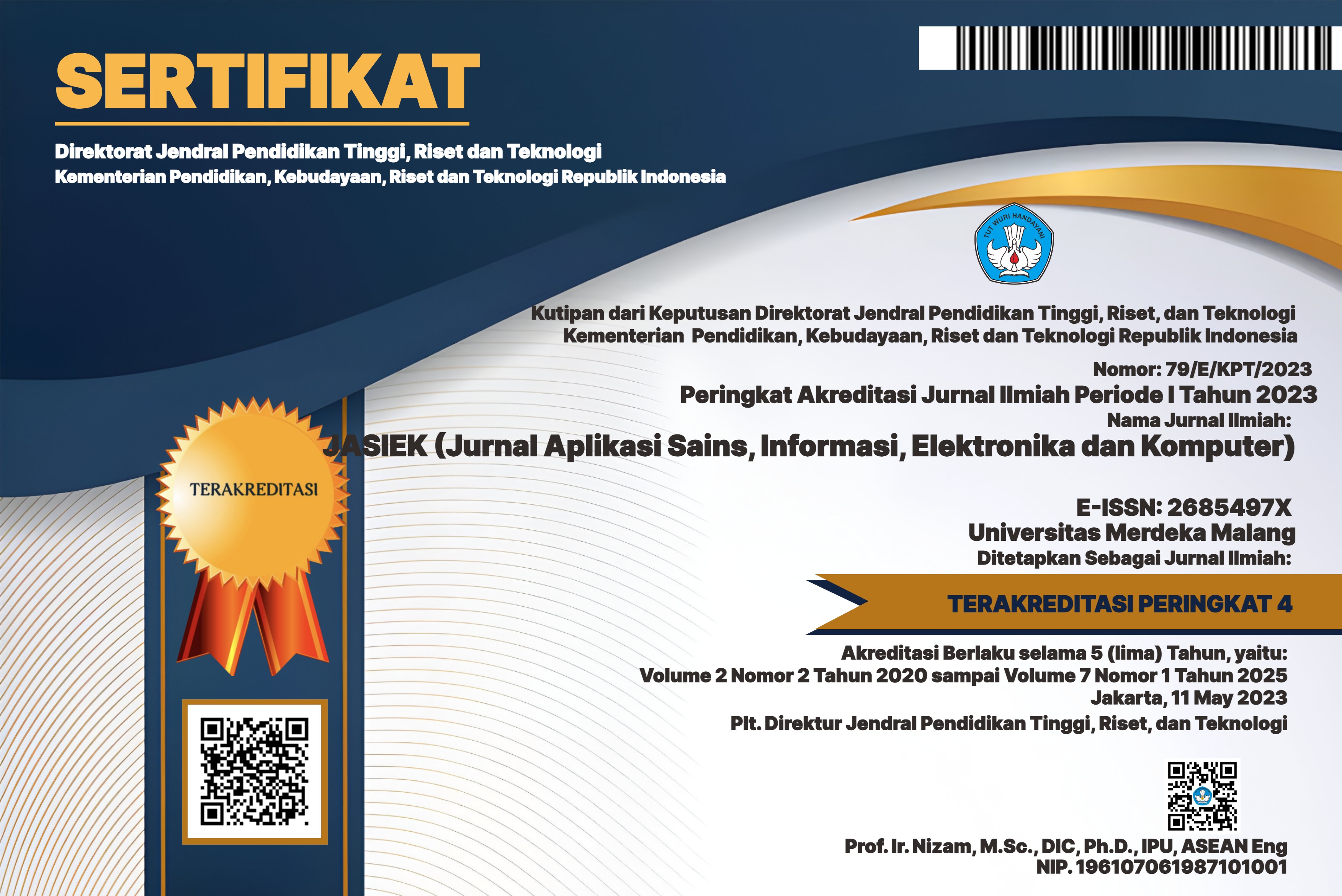Penerapan PID (Proportional Integral Derivative) Untuk Mengontrol Mode Manual Drone Hexacopter
DOI:
https://doi.org/10.26905/jasiek.v2i1.3944Abstract
Meminimalisir kerugian materiil dan non-materiil dalam sebuah tugas operasi adalah hal mutlak dalam sebuah strategi agar tidak memberikan dampak yang mampu merusak sebuah strategi. Untuk menerapkannya adalah menggunakan teknologi yang memiliki sistem kontrol yang baik. Sistem kontrol yang sering digunakan untuk kontrol secara manual adalah pengendali PID , dimana sistem kontrol jenis ini memiliki refrensi berdasarkan dari konstanta nilai – nilai Propotional, Integral dan Derivative. Penerapan PID ini berdasarkan dari nilai refrensi, dimana nilai tersebut dihasilkan melalui trial and error. Agar mendapatkan nilai kombinasi yang sesuai sebelum hasil output ini dikirim ke ESC sebagai acuan pergerakan kecepatan motor brushless. Konstanta pengendali PID untuk mencapai kestabilan saat hexacopter menembak adalah Kp=130; Ki=0; Kd=0,076. Hasil dari pengujian yaitu nilai rise time sebesar 0,0526 detik, settling time sebesar 0,783, overshoot sebesar 0,205% dan steady state error 1%.
Kata Kunci: Drone, Hexacopter, PID
Downloads
References
Amin, Z., Meldi, (2018). Pengidentifikasian dan Pencarian Manusia Berbasis Citra Menggunakan Unmaned Aerial Vehicle. Universitas Andalas. Metal: Jurnal Sistem Mekanik dan Termal Vol. 02 No. 02 (2018) hal. 50-61.
Dharmawan, A. (2009). Pengendalian Motor Brushless DC Dengan MEtode PWM Sinusoidal Menggunakan ATMEGA16. Universitas Indonesia, Depok.
T. A. S, A. Rabi’, D. Minggu, And I. Mujahidin, “Frequency Hopping Video Real Time Untuk Pengamanan Data Pengintaian Operasi Inteligence Tni,†Jasiek (Jurnal Apl. Sains, Informasi, Elektron. Dan Komputer), 2019.
Habibi, G. Akbar. (2013). Perancangan Dan Analisis Otomasi Sistem Kendali Quadcopter Melalui Koordinat Dengan Global Positioning System Tracker. Institut Teknologi Telkom.
A. E. Pambudi, L. Maajid, J. Rohman, And I. Mujahidin, “Aplikasi Penggunaan Joystick Sebagai Pengendalian Remote Control Weapon Station (RCWS) Senjata Mesin Ringan (Smr),†Jasiek (Jurnal Apl. Sains, Informasi, Elektron. Dan Komputer), Vol. 1, No. 2, Pp. 98–105, 2019.
Majid, M, (2016). Implementasi Arduino Mega 2560 untuk Kontrol Miniatur Elevator Barang Otomatis. Universitas Negeri Semarang.
Putra, Bagus T.P. (2019). Sistem Kendali Senjata Robot Tempur Dengan Metode Proportional Integral Derivative (PID). Universitas Merderka Malang.
Putra, R.P. (2016). Aplikasi GPS APM2.5 NEO-6M Pada Robot Terbang Pendeteksi Asap. Politeknik Negeri Sriwijaya.
Ramzy, M.D. (2016). Pengontrol Motor Brushless 2300 KV Menggunakan ESC 12A Pada Drone Quadcopter Berbasis Flight Controller Pixhawk. Politeknik Negeri Sriwijaya.
E. Endrayana, D. H. S. Wahyuni, N. Nachrowie, And I. Mujahidin, “Variasi Ground Plane Antena Collinear Pada Pemancar Telivisi Analog Dengan Frekuensi Uhf 442 Mhz,†Jasiek (Jurnal Apl. Sains, Informasi, Elektron. Dan Komputer), Vol. 1, No. 2, Pp. 149–156, 2019.
Ridhwan, M. T. (2012). Rancang Bangun Penggerak Daya Motor Brushless DC 350W/48V. Politeknik Negeri Bandung, Bandung.
Rohimah. (2016). Pengamanan Pendeteksi Sayatan Menggunakan Teknologi Global Positioning System (GPS) Dengan Sensor LDR Via Short Masaage Service (SMS). Politeknik Negeri Sriwijaya.
Downloads
Published
Issue
Section
License
Authors who publish with this journal agree to the following terms:
The journal allow the authors to hold the copyright without restrictions and allow the authors to retain publishing rights without restrictions.
Authors retain copyright and grant the journal right of first publication with the work simultaneously licensed under a Creative Commons Attribution-ShareAlike 4.0 International License that allows others to share the work with an acknowledgement of the work's authorship and initial publication in this journal.
Authors are able to enter into separate, additional contractual arrangements for the non-exclusive distribution of the journal's published version of the work (e.g., post it to an institutional repository or publish it in a book), with an acknowledgement of its initial publication in this journal.
Authors are permitted and encouraged to post their work online (e.g., in institutional repositories or on their website) prior to and during the submission process, as it can lead to productive exchanges, as well as earlier and greater citation of published work (See The Effect of Open Access).

This work is licensed under a Creative Commons Attribution-ShareAlike 4.0 International License.










